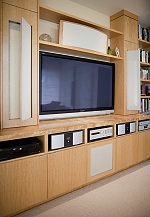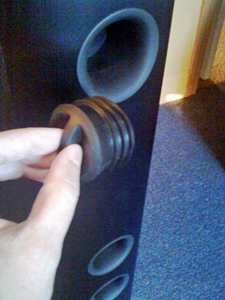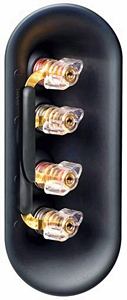Introduction
Paul S. Barton has been in the loudspeaker game for over 35 years and his latest iteration of speakers shows that his experience has been put to good use. The Synchrony Ones are his top of the line 3-way (5 drivers) towers that use some interesting design twists. At nearly 61 pounds a piece, they make an elegant statement of curved wood and aluminum surfaces that blend together in a flawless fashion. But beauty is more than good looks. Can they sound as good as they look? After spending several weeks listening to them, I admit that I was impressed with their sound. In fact, I was very impressed!
Specifications
- Design: 3-Way, Ported
- Drivers: One 1″ Titanium Dome Tweeter, One 4″ Midrange, Three 6.5″ Woofers
- MFR: 33 Hz – 20 kHz, ± 1.5 dB
- Nominal Impedance: 4 Ohms
- Sensitivity: 90 dB/2.83v/m
- Crossover Frequencies: 500 Hz, 2.2 kHz
- Maximum Power: 300 Watts
- Dimensions: 43″ H x 8.75″ W x 12.75″ D
- Weight: 61 Pounds/each
- Finish: Black Ash or Dark Cherry
- MSRP: $5,000/pair USA
- PSB Speakers
Design
The front baffle, back panel and base of the Synchrony Ones are made of extruded aluminum. Actually, the front baffle is constructed of two aluminum layers, which allows for the drivers to be mounted to the back layer with a rubber molding surrounding the drivers and extending to the front layer. This gives the drivers a very solid footing with minimal energy transferred to the front-most portion of the baffle to keep resonances down. Cosmetically, the rubber molding also covers up the drivers’ unsightly screws. The result is a surface that blends seamlessly from wood to metal. The curved side panels are made from seven-ply MDF that’s finished with a real-wood veneer. The very top is also MDF and veneer, but it’s flat. The wood layers are glued and “microwaved’ to create a very solid and resonant free panel that is then locked in together with the slotted aluminum front panel. The result is a very solid and stiff cabinet that allows the sound to come from the drivers and not the cabinet. Rapping my knuckles along the outside of the cabinets revealed no echo or hollow sounds. The grilles are magnetically attached and a pull tab allows you to pull the grilles off. No worries about a child pulling them off by accident. It took me a while to get them off. The speakers look very good with them on or off as there are no holes for screws or pins on the front baffle. The bulk of my reviewing was done with them off. I heard no obvious sonic degredation with them on, but I liked the look of them with the drives au natural. The cabinets come in black ash (as reviewed) or dark cherry.
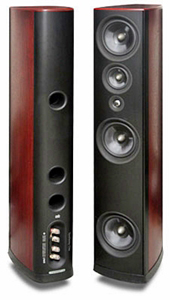
The drivers and cross over network are special as well. The tweeter is a 1 inch titanium dome with ferrofluid cooling. The 4 inch midrange is made from a sandwich laminate fine weave fiberglass/natural fiber combination. There are 3 woofers that are equally spaced from top to bottom made of the same material as the midrange. The spacing is intentionally designed to help eliminate standing waves in the room and “floor bounce”. Each woofer is tuned a little differently from each other, but their combined effect gives the Ones a smooth bass response. A port plug is provided for fine tuning the bass in your particular room (more can be ordered as needed). Since each woofer is in its own enclosure, it gives you the ability to plug one, two or all three ports…or none at all. It is well known that a room can dominate the bass performance below 200Hz and the added flexibility of port covers can improve the performance in a problem room. This is a great “plus” if you are a tweakophile!
In anycase, each woofer is housed in its own section, with the tweeter and midrange sharing the space with the middle woofer. 5 way binding posts are in the back with the ports. The Ones can be bi-wired/bi-amped. The Ones have decent sensitivity, but its impedance is on the low side and likely to cause some amplifiers grief if they can’t handle a tough load.
The posts are canted slightly to the right on both speakers. I would have preferred that they were mirrored and facing toward the middle, but that is a small gripe on my part. The “wing-nut” design made loosening the posts a breeze. Spikes/rubber feet are supplied for the bottom. All in all, these speakers have a seamless finish and solid construction feel to them and visually look quite nice.
The cross-over design is a forth order Linkwitz-Riley type with attention paid to direction of the “in phase lobe”. The lobe, an inevitable transition from one driver to the other, is optimally aimed so whether you are sitting or standing, the frequency response of the system does not vary. Film capacitors are used for the mids and trebles. The woofers utilize a progressive (gradually tightening) suspension that reduces distortion and clipping when pushed beyond their limits. Suffice it to say, I could never find their limit with my auditioning. The woofer magnets are 20mm thick, so they are not likely to bottom out. I have no doubt the woofers can get down to their claimed 30Hz, which is impressive for almost any speaker. The mids and woofers also have a phase plug (bullet) to help reduce distortion and assist in cooling the voice coils. The bullets also contribute to the overall fine look of these speakers with the grilles taken off.
Setup and Performance
I moved my Revel F12s out of the room (again) and placed the Ones equi-distanced from my normal seating spot eight feet away. I toed them in slightly, but did not notice much frequency shifting even with them facing full forwards. A foot and half from the back wall and around three feet from the sides and I was ready to go. My speaker cables were Zu Audio Julians with banana connectors which snapped into the posts with a solid click. Obviously, bare wire or spades will work as well, but I have always preferred the ease and convenience of bananas. I experimented with the port plugs, but couldn’t get a dramatic sound change (better or worse), so I did most of my listening sans plugs. PSB offered to send me more, but I declined. In hind sight, I probably should have taken them up on the offer just to experiment with them.( I won’t decline an offer of “free” or “more” in the future). It is nice that PSB gives you that option, though. I noticed that the tweeter height was actually positioned slightly below ear level from my usual listening position, but found that the treble was not diminished in any of my actual listening. For much of my auditioning, I normally listen to classical music and pay close attention to instrument timbre and dimensionality of the soundstage. In all respects, the Ones reproduced music to louder than realistic levels with no audible distortion or distress.
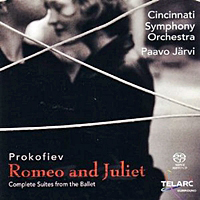
Prokofiev’s Romeo and Juliet Suite, whether in surround or stereo, presented a wide and deep stage across the front of my room. Instruments from the piccolo to the kettle drums all sounded very natural and defined in their own space. Nuances, like sheet music or a bow skittering along a string were all captured in magnificent detail. As on most Telarc recordings, the dynamic range goes from deathly silence to full crescendo in a heart beat…and the Ones never faltered in their open and coherent presentation.
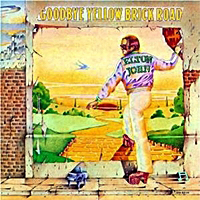
For a rocking good time, I also played some “Goodbye Yellow Bick Road” by Elton John. This SACD has remarkable sonics and a delightful 3D musical spread. Piano, voice and electric guitars sounded very good. Piano and voice can be good indicators of midrange reproduction and the Ones produced very natural, life-like sound. Drums had kick and punch. If you have the power, these speakers really opened up nicely when your in the mood to loosen your tie! I’m a bit “old school”, so I also listened to a lot of The Doors, The Who, Beatles, Moody Blues and Milli Vanilli (Oops!…just kidding). They all sounded great, though some of the recordings really had their warts and blemishes exposed by the Synchronys. I am O.K. with that. A good speaker should never mask the truth in a recording.
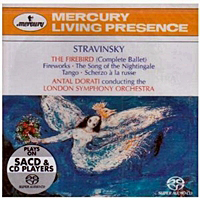
Stravinsky’s “The Firebird” allowed me to assess the bite of the strings as well as demonstrating the PSBs ability to handle complex musical structures…and timpani. The Ones are not in need of being bolstered by a subwoofer. You can certainly add one to the mix, but the Ones went low enough for me, a pipe organ enthusiast. Powerful, tight bass notes could be felt and distingushed. The very low notes were not just jumbled together, but retained their distinction from each other. It quickly became apparent to me that the Ones were very neutral and uncolored in their presentation, as well. It’s somewhat hard to describe, but you know how other speakers are often referred to as having “tight bass” or “beautiful mids” or “highs that really sizzle”? With the Ones, they do all of that stuff very well, but I can think of no speaker that I have listened to in the last several years that blend all three elements so seemlessly. No one range was dominant. All three drivers worked together so seamlessly, that I can not point out a specific “sonic character” to describe them. Treble was smooth, but not bright. Mid range was open and natural, but not too forward. Bass was tight and deep, but never overpowering or loose. Considering their close proximity to my front wall, I expected some low end boost, but it never reared its ugly head. Just the clarity, accuracy and detail of the music were being presented. In part, I can attribute this seemless blend to the fourth-order slopes of the crossovers that eliminated so much of the driver overlap that you sometimes get with other speakers. No matter what music (or movies) I listened to with the Synchrony Ones, I was impressed with what I heard. Cohesive sound, without any one particular audio frequency being over or under emphasized. Like Goldilocks would have said, “This one is just right!” These are speakers that you would never tire of listening to over the years. The money you could save by not “upgrading” speakers every other year would more than justify the price of the Synchrony Ones.
Conclusions
Well, perhaps I was more than just impressed. The PSB Synchrony Ones are one the best sounding speakers I have had the pleasure to audition in my home. The overall sonic performance was exceptionally good, with a wide and deep sonic soundstage with all of my music. The drivers all blend perfectly. The build quality is nothing short of extraordinary for both its solidity and style. Are they worth the asking price? I think so. Paul Barton and his team have put a lot of research, time and effort into these speakers and the results really do speak for themselves. I recommend that you audition these speakers if you get the chance and hear for yourself what a well designed, finely crafted speaker can sound like. You too might be equally impressed. Highly recommended!


